Starting a profitable blogging business requires careful planning, consistent effort, and a strategic approach. Here’s a step-by-step guide to help you get started:
Choose a Profitable Niche: Select a niche that aligns with your interests, expertise, and has the potential to attract a sizable audience. Conduct market research to identify profitable niches with high demand and low competition.
Define Your Target Audience: Understand your target audience’s demographics, interests, problems, and preferences. Tailor your content to address their needs and provide value, which will help you attract and retain readers.
Create a Business Plan: Develop a comprehensive business plan outlining your blogging goals, target audience, monetization strategies, content strategy, and marketing tactics. Define your unique selling proposition (USP) and set realistic short-term and long-term goals.
Choose a Blogging Platform and Domain Name: Select a blogging platform such as WordPress, Blogger, or Squarespace, and register a domain name that reflects your brand and niche. Choose a reliable web hosting provider to ensure your website is secure and performs well.
Design Your Blog: Customize your blog’s design and layout to create a visually appealing and user-friendly experience. Choose a responsive theme, optimize your website for mobile devices, and ensure easy navigation.
Create High-Quality Content: Develop a content strategy focused on producing valuable, informative, and engaging content that resonates with your target audience. Consistently publish blog posts, articles, tutorials, videos, or podcasts that address their interests, questions, and pain points.
Monetize Your Blog: Explore various monetization strategies to generate revenue from your blog, such as:
- Affiliate Marketing: Promote products or services related to your niche and earn commissions for every sale or referral.
- Display Advertising: Place ads on your blog using ad networks like Google AdSense or Media.net to earn revenue based on impressions or clicks.
- Sponsored Content: Partner with brands or companies to create sponsored posts, reviews, or sponsored social media campaigns.
- Digital Products: Create and sell digital products such as e-books, online courses, templates, or software.
- Membership Sites: Offer premium content, exclusive resources, or community access through a membership subscription model.
Build Your Audience: Implement effective marketing strategies to attract and grow your blog’s audience. Utilize social media platforms, email marketing, SEO, guest blogging, influencer collaborations, and networking to increase visibility and drive traffic to your blog.
Optimize for SEO: Implement on-page and off-page SEO techniques to improve your blog’s search engine rankings and organic visibility. Conduct keyword research, optimize your content, build quality backlinks, and monitor your website’s performance using analytics tools.
Engage with Your Audience: Foster engagement and build relationships with your audience by responding to comments, emails, and social media messages. Encourage interaction, feedback, and user-generated content to create a community around your blog.
Track Your Progress and Iterate: Monitor your blog’s performance, and track key metrics such as traffic, engagement, conversion rates, and revenue. Analyze the data, identify areas for improvement, and continuously iterate your strategies to optimize results and grow your blogging business.
Starting a profitable blogging business requires dedication, patience, and perseverance. Focus on providing value to your audience, building your brand, and implementing effective monetization strategies to achieve long-term success.






